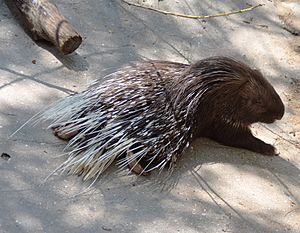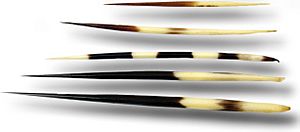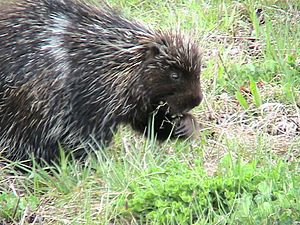Porcupine facts for kids
Quick facts for kids Porcupine |
|
|---|---|
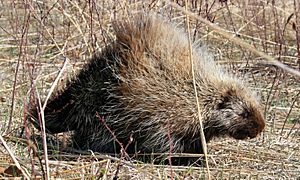 |
|
| North American porcupine | |
| Scientific classification | |
| Kingdom: | Animalia |
| Phylum: | Chordata |
| Class: | Mammalia |
| Order: | Rodentia |
| Suborder: | Hystricomorpha |
| Infraorder: | Hystricognathi |
| Groups included | |
|
|
| Cladistically included but traditionally excluded taxa | |
|
|
Porcupines are large rodents known for their coats of sharp spines, called quills. These quills help protect them from animals that might try to eat them. The word "porcupine" actually refers to two main groups of these animals: the Old World porcupines and the New World porcupines.
Both groups have similar spiky coats, but they are not closely related. They both belong to a larger group of rodents called Hystricognathi. The biggest porcupine species is the third-largest living rodent in the world, after the capybara and the beaver.
Old World porcupines live in Italy, parts of Asia, and most of Africa. They are big, live on the ground, and are active mostly at night.
New World porcupines are found in North America and northern South America. They live in forests and are good at climbing trees. Some even spend their whole lives in trees! They are often smaller than Old World porcupines and are not as strictly nocturnal.
Most porcupines are about 25 to 36 inches (64 to 91 cm) long, with a tail that is 8 to 10 inches (20 to 25 cm) long. They weigh between 12 and 35 pounds (5.4 and 16 kg). They are usually rounded, large, and move slowly. Their colors are often shades of brown, grey, and white. Their spiky defense is similar to that of hedgehogs and echidnas, though these animals are not closely related.
Contents
What's in a Name?
The word "porcupine" comes from old Latin words. Porcus means "pig" and spina means "spine" or "quill." So, it basically means "thorn-pig." In some places, they are even called "quill-pigs."
A baby porcupine is called a porcupette. When they are born, their quills are soft, like hair. But within a few days, these quills harden and become sharp, just like an adult's.
Porcupine History
Fossils of porcupines, specifically from the Hystrix group, have been found in Africa. These fossils show that porcupines have been around since the late Miocene epoch.
Types of Porcupines
There are about 30 different kinds of porcupines. They belong to two main families: the Erethizontidae family and the Hystricidae family.
Porcupines can be very different in size. For example, Rothschild's porcupine from South America weighs less than 2.2 pounds (1 kg). But the crested porcupine, found in Italy, North Africa, and sub-Saharan Africa, can weigh over 60 pounds (27 kg)! Even though both families are part of the larger Hystricognathi group of rodents, they are not closely related.
Old World vs. New World Species
The 11 types of Old World porcupines are usually quite large. Their spines grow in groups or clusters.
The New World porcupines are generally smaller. For example, the North American porcupine can reach about 33 inches (85 cm) long and weigh 40 pounds (18 kg). Their quills are attached one by one, not in clusters. New World porcupines are also excellent climbers and spend a lot of time in trees. They developed their spines on their own, through a process called convergent evolution. This means they evolved similar traits even though they are not closely related.
How Long Do They Live?
Porcupines can live for a long time. They hold the record for being the longest-living rodents. One porcupine named Cooper lived for over 32 years!
What Do They Eat?
The North American porcupine is a herbivore, meaning it eats plants. It often climbs trees to find food like leaves, twigs, and green plants such as clover. In winter, it might even eat tree bark.
The African porcupine does not climb trees. Instead, it looks for food on the ground. It is mostly active at night, but sometimes it will search for food during the day. It eats bark, roots, fruits, berries, and even farm crops. In Kenya, porcupines can be a problem for farmers, but they are also eaten as a special food.
How They Defend Themselves
Porcupines use their sight, smell, and sound to defend themselves. They show these behaviors when they feel bothered or upset. There are four main ways a porcupine defends itself, from least to most aggressive:
- Raising Quills: They make their quills stand up.
- Clattering Teeth: They make a loud noise by clattering their teeth together.
- Emitting Odor: They release an unpleasant smell.
- Attacking: They might run sideways or backwards into a predator.
A porcupine's black and white coloring helps with defense. Many predators are active at night and cannot see colors well. When a porcupine raises its quills, the white stripe down its back looks a bit like a skunk, which can scare off predators.
Along with raising their quills, porcupines clatter their teeth to warn others to stay away. They also shiver their bodies to make their dangerous quills even more obvious. The hollow quills at the back of their body help make a rattling sound. If these warnings don't work, the porcupine might release a bad smell from its skin above the tail.
If all else fails, a porcupine will attack. It might run sideways or backwards into a predator. It can also swing its tail. If the quills hit the predator, they can get stuck, causing injury or even death.
About Their Quills
Porcupine quills are special modified hairs. They are covered with thick, hard plates made of keratin, which is the same material as your fingernails. The quills are held in place by muscles in the skin. Old World porcupines have quills that grow in clusters, while New World porcupines have single quills mixed with other hair.
Quills can come off when a porcupine is touched, or they might fall out if the porcupine shakes its body. New quills will grow back to replace the lost ones. It's a common myth that porcupines can shoot their quills. They cannot!
Some scientists believe that porcupine quills might have properties that help fight germs. This could help a porcupine if it accidentally hurts itself with its own quills.
Porcupines and People
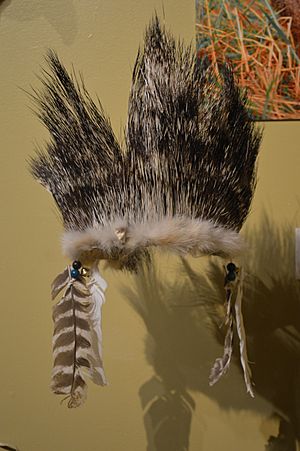
In Western countries, people usually don't eat porcupines. However, they are often eaten in Southeast Asia, especially in Vietnam. Because so many are eaten, porcupine populations have gone down in some areas. Some people who have tried North American porcupine meat say it tastes very strong and not very good.
More often, porcupine quills and guard hairs are used for decorations. For example, Native American people use their guard hairs to make special headdresses called "porky roaches." The main quills can be dyed and then sewn onto leather items like knife covers or bags. Lakota women would collect quills for their artwork by throwing a blanket over a porcupine. The quills would stick to the blanket, making them easy to gather.
The quills have tiny hooks, called barbs, at their tips. These barbs make it painful to remove a quill once it has poked the skin. The shape of the barbs helps the quills go into the skin easily and stay there. Scientists have studied porcupine quills to help design new medical tools, like hypodermic needles and surgical staples. Unlike regular surgical staples, a design based on porcupine quills could go in easily and stay in place without needing to be bent. Sometimes, people also keep porcupines as pets.
Where They Live
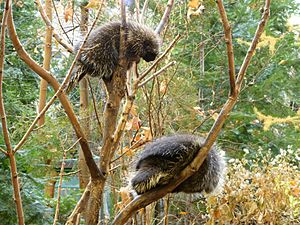
Porcupines live in many different places around the world. You can find them in tropical and mild parts of Asia, Southern Europe, Africa, and North and South America. They live in forests, deserts, rocky areas, and hillsides. Some New World porcupines live in trees, but Old World porcupines prefer rocky ground. They can even be found in rocky areas as high as 12,100 feet (3,700 meters). Porcupines are usually active at night, but sometimes you might see them during the day.

Porcupine Classification
Porcupines are divided into two main groups within the larger rodent group called Hystricomorpha.
- Infraorder Hystricognathi
- Family Hystricidae: Old World porcupines
- African brush-tailed porcupine, Atherurus africanus
- Asiatic brush-tailed porcupine, Atherurus macrourus
- Crested porcupine, Hystrix cristata
- Cape porcupine, Hystrix africaeaustralis
- Indian porcupine, Hystrix indicus
- Malayan porcupine, Hystrix brachyura
- Himalayan porcupine, Hystrix (brachyura) hodgsoni
- Sunda porcupine, Hystrix javanica
- Sumatran porcupine, Hystrix (Thecurus) sumatrae
- Thick-spined porcupine, Hystrix (Thecurus) crassispinis
- Philippine porcupine, Hystrix (Thecurus) pumilis
- Long-tailed porcupine, Trichys fasciculata
- Parvorder Phiomorpha sensu stricto
- Family Thryonomyidae: cane rats
- Family Petromuridae: Dassie rats
- Family Bathyergidae: African mole-rats
- Parvorder Caviomorpha
- Superfamily Erethizontoidea
- Family Erethizontidae: New World porcupines
- Brazilian porcupine, Coendou prehensilis
- Bicolored-spined porcupine, Coendou bicolor
- Andean porcupine, Coendou quichua
- Black dwarf (Koopman's) porcupine, Coendou nycthemera (koopmani)
- Rothschild's porcupine, Coendou rothschildi
- Santa Marta porcupine, Coendou sanctemartae
- Mexican hairy dwarf porcupine, Coendou mexicanus
- Paraguaian hairy dwarf porcupine, Coendou spinosus
- Bahia porcupine, Coendou insidiosus
- Brown hairy dwarf porcupine, Coendou vestitus
- Streaked dwarf porcupine, Coendou ichillus
- Black-tailed hairy dwarf porcupine, Coendou melanurus
- Roosmalen's dwarf porcupine, Coendou roosmalenorum
- Frosted hairy dwarf porcupine, Coendou pruinosus
- Stump-tailed porcupine, Coendou rufescens
- North American porcupine, Erethizon dorsatum
- Bristle-spined porcupine, Chaetomys subspinosus (sometimes considered an echimyid)
- Family Erethizontidae: New World porcupines
- Superfamily Cavioidea
- Family Hydrochaeridae: capybara
- Family Caviidae: Guinea-pigs
- Family Dasyproctidae: agoutis and acouchis
- Superfamily Octodontoidea
- Family Abrocomidae: chinchilla-rats
- Family Octodontidae: degus
- Family Ctenomyidae: tuco-tucos
- Family Echimyidae: spiny rats
- Family Myocastoridae: nutrias
- Family Capromyidae: hutias
- Superfamily Chinchilloidea
- Family Chinchillidae: chinchillas and allies
- Family Dinomyidae: pacaranas
- Superfamily Erethizontoidea
- Family Hystricidae: Old World porcupines
See also
 In Spanish: Puercoespín para niños
In Spanish: Puercoespín para niños
- Pangolins, another mammal group with protective keratin body coverings
- Armadillos, another mammal group with protective keratin body coverings


